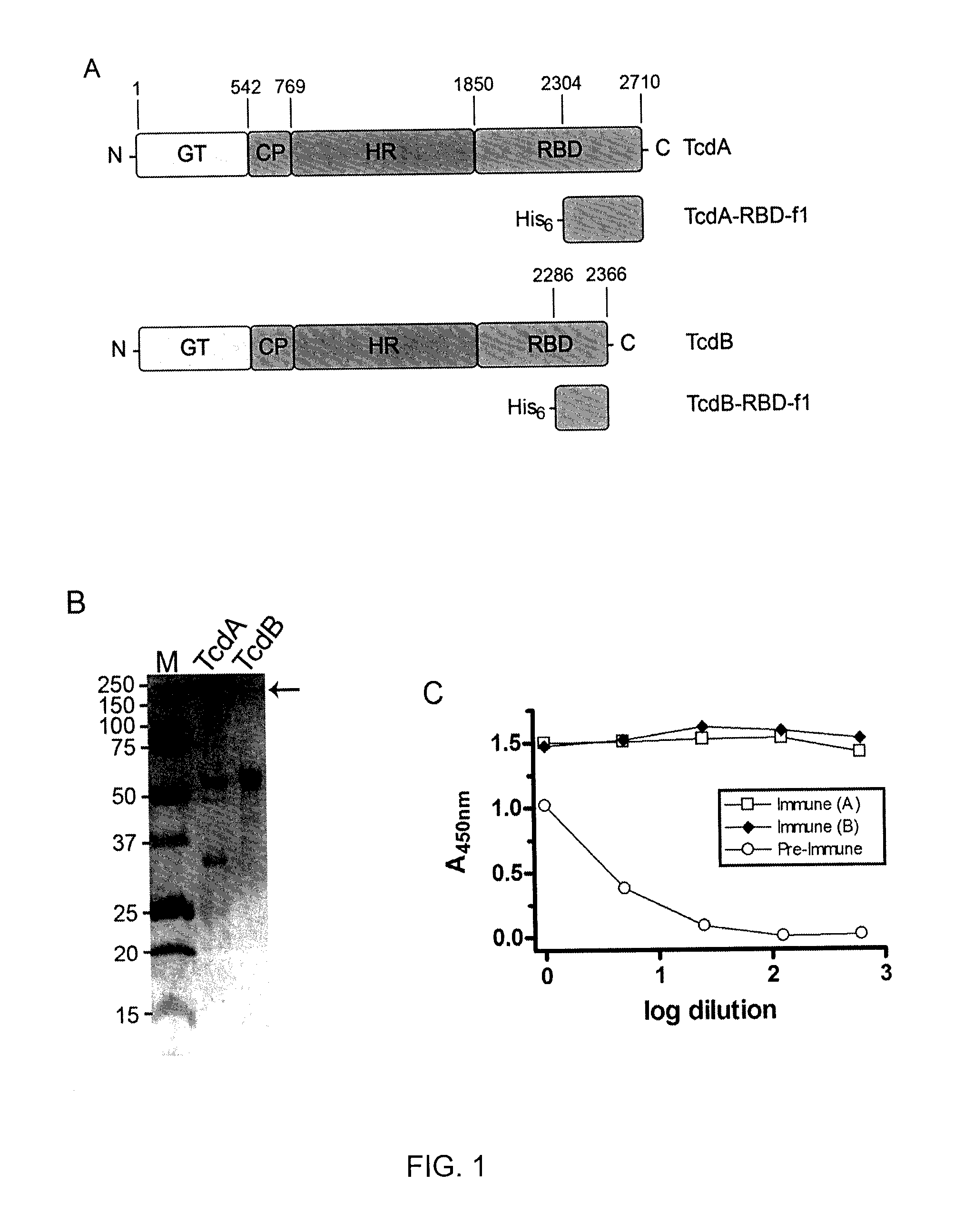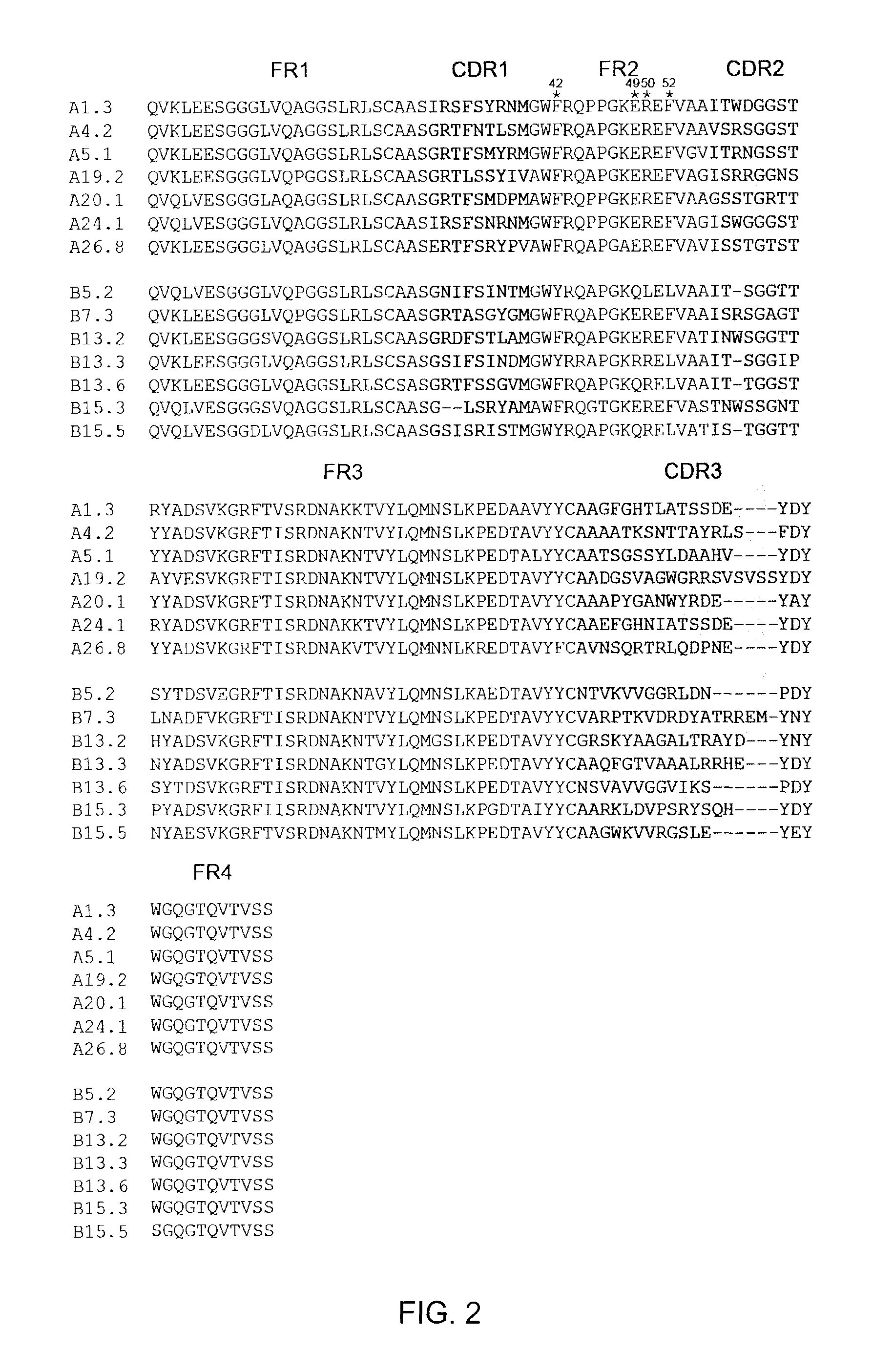Clostridium difficile-specific antibodies and uses thereof
a technology of specific antibodies and clostridium difficile, which is applied in the field ofclostridium difficile toxinspecific antibodies, can solve the problems of no acute cdad treatment targeting tcda/b, thousands of deaths, and $1 billion in associated costs for the health care system, and achieves reduced affinities of 3 of 4 vhhs, increased thermal stability and gi protease resistance, and increased stability
- Summary
- Abstract
- Description
- Claims
- Application Information
AI Technical Summary
Benefits of technology
Problems solved by technology
Method used
Image
Examples
example 1
Purification of Toxins and Recombinant Fragments
[0127]C. difficile-associated diseases (CDAD) are caused by two high-molecular weight toxins composed of enzymatic, translocation, and cell-receptor binding domains (RBD; FIG. 1A). TcdA and TcdB toxins were purified from natural sources, and recombinant fragments thereof were prepared.
[0128]TcdA and TcdB were isolated from Clostridium difficile strain 10463 (ATCC, Manassas, Va.) as described previously (Keel and Songer, 2007) and were stored in 50 mM Tris-HCl buffer pH 7.5 at 4° C. The SDS-PAGE profile of the purified C. difficile toxins (3 μg per lane; from strain 10463) used is shown in FIG. 1B.
[0129]Recombinant fragments of TcdA (amino acid residues 2304-2710) and TcdB (amino acid residues 2286-2366), which are fragments of the RBD, were cloned (as a BamHI-HindIII fragment for tcdA and a BamHI-EcoRI fragment for tcdB) into pTrcHisB (Invitrogen, Carlsbad, Calif.), transforming E. coli DH5aMCR. Expression was induced by IPTG, cells ha...
example 2
Llama Immunization and Serum Response
[0130]To isolate VHHs which target the RBD of toxin A (TcdA) and toxin B (TcdB), a llama was immunized with recombinant RBD fragments TcdA-RBD-f1 and TcdB-RBD-f1 (FIG. 1A) obtained in Example 1.
[0131]One male llama (Lama glama) was immunized by sub-cutaneous, lower-back injection of TcdA-RBD-f1 and TcdB-RBD-f1 antigens. On Day 1, 200 μg of each antigen diluted in PBS to 1 ml was injected with 1 ml of Freund's Complete Adjuvant (Sigma, St. Louis, Mo.). Three more injections of 100 μg of each antigen+Freund's Incomplete Adjuvant (Sigma) were performed on Days 22, 36, and 50. A final injection of 100 μg of each antigen with no adjuvant was performed on Day 77. Pre-immune blood was drawn before the first injection on Day 1 and served as a negative control. Blood (10-15 ml) was collected on Days 29, 43, 57 and 84. Pre-immune and post-immune total serum was analyzed for a specific response to TcdA-RBD-f1 and TcdB-RBD-f1 by ELISA on Day 57 (see below). ...
example 3
Library Construction and Selection of Toxin-Binding VHHs
[0133]A hyperimmunized llama VHH library was constructed based on RNA isolated from the serum collected in Example 2.
[0134]Library construction and panning was performed essentially as previously described (Arbabi-Ghahroudi et al, 2009c, 2009b; Tanha et al, 2003). Total RNA was isolated from approximately 5×106 lymphocytes collected on day 84 post-immunization using the QlAamp RNA Blood Mini Kit (QIAGEN, Mississauga, ON, Canada). About 5 μg of total RNA was used as template for first strand cDNA synthesis with oligo dT primers using the First-Strand cDNA Synthesis Kit (GE Healthcare, Baie-d'Urfé, QC, Canada). The cDNA was amplified by an equimolar mix of three variable region-specific sense primers:
MJ1:(SEQ ID NO: 56)5′-GCCCAGCCGGCCATGGCCSMKGTGCAGCTGGTGGAKTCTGGGGGA-3′MJ2:(SEQ ID NO: 57)5′-CAGCCGGCCATGGCCCAGGTAAAGCTGGAGGAGTCTGGGGGA-3′MJ3:(SEQ ID NO: 58)5′-GCCCAGCCGGCCATGGCCCAGGCTCAGGTACAGCTGGTGGAGTCT-3′,
and two antisense CH2-spe...
PUM
| Property | Measurement | Unit |
|---|---|---|
| Tm | aaaaa | aaaaa |
| Tm | aaaaa | aaaaa |
| Tonset temperatures | aaaaa | aaaaa |
Abstract
Description
Claims
Application Information
 Login to View More
Login to View More - R&D
- Intellectual Property
- Life Sciences
- Materials
- Tech Scout
- Unparalleled Data Quality
- Higher Quality Content
- 60% Fewer Hallucinations
Browse by: Latest US Patents, China's latest patents, Technical Efficacy Thesaurus, Application Domain, Technology Topic, Popular Technical Reports.
© 2025 PatSnap. All rights reserved.Legal|Privacy policy|Modern Slavery Act Transparency Statement|Sitemap|About US| Contact US: help@patsnap.com



